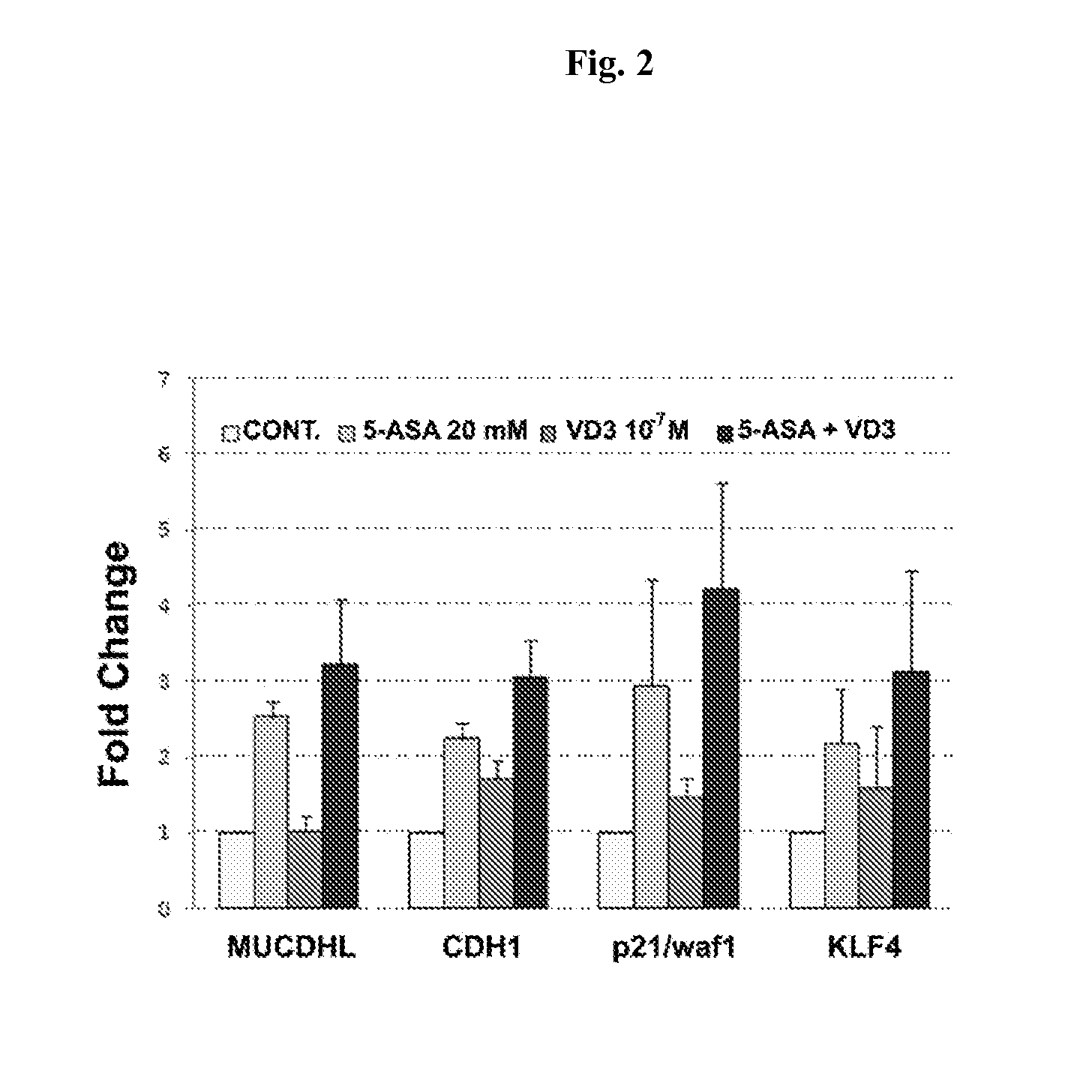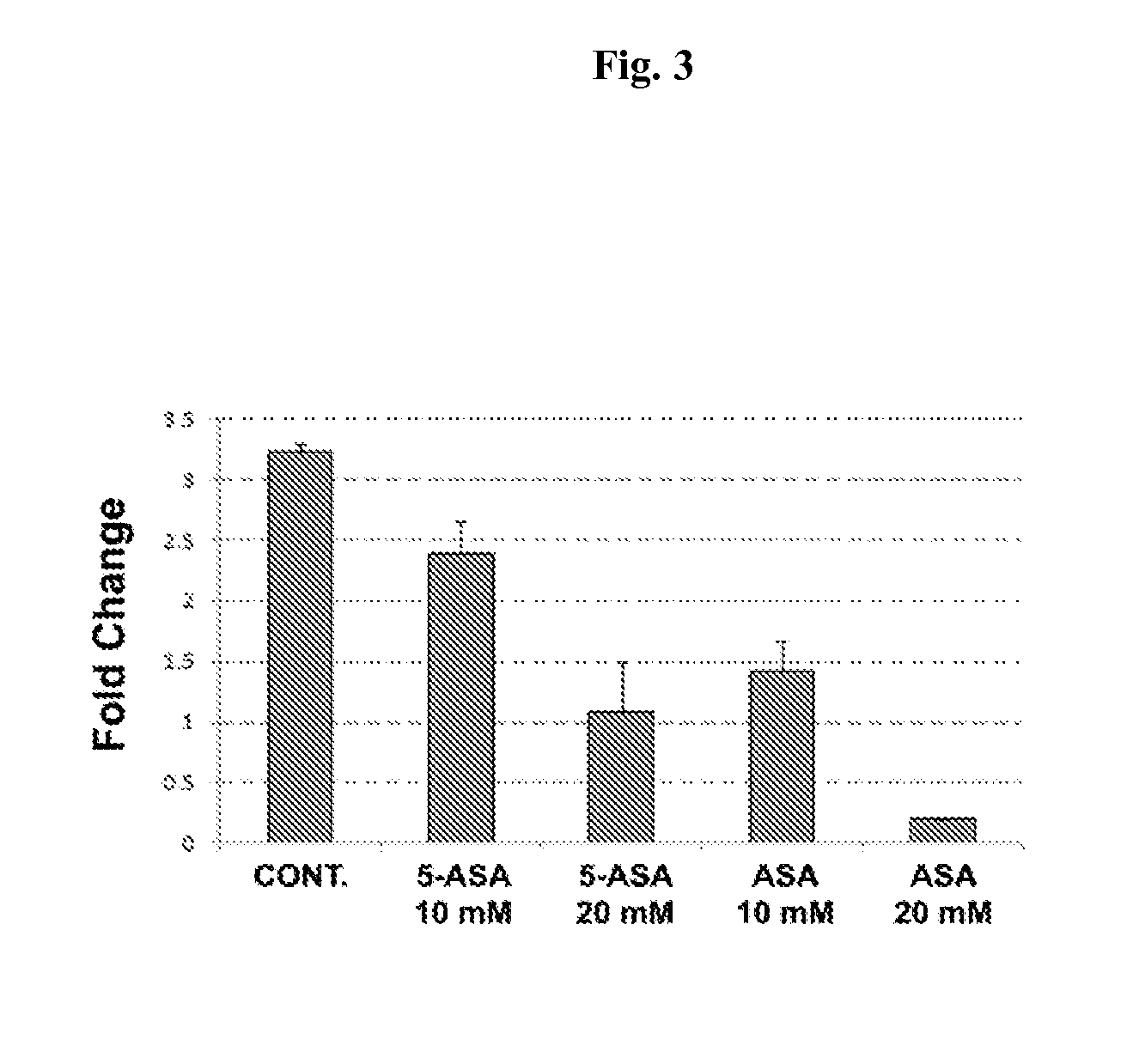Chemoprevention of colorectal cancer
a colorectal cancer and chemotherapy technology, applied in the field of nsaids and steroidal anti-inflammatory drugs, can solve the problems of systemic and gastrointestinal toxicity of nsaids and drastically limit the administration
- Summary
- Abstract
- Description
- Claims
- Application Information
AI Technical Summary
Benefits of technology
Problems solved by technology
Method used
Image
Examples
example 1
Analysis of the Antiproliferal Effects Promoted by Treatment with 5-ASA and VD3 of the Adenocarcinoma Cell Line HT29 of the Colon-Rectum
[0030]The colorectal adenocarcinoma cell line HT29, which was chosen for its responsiveness to the VD3 deriving from the corresponding VDR receptor, was subjected to “in vitro” treatment with 5-ASA 20 mM and VD3 10−7 M, used individually and in association, in order to quantify the antiproliferative effect determined by the compounds analysed on cancerous colonocytes. The plotting of the growth curves, based on cell-count values obtained from this experiment, has shown that the treatment combined with 5-ASA and VD3 determines an additional antiproliferative effect that is clearly superior to what has been observed with the single treatments. This observation is evident above all at 96 hours of stimulation, where 14 expansions were detected in the control, 8 times in the treatment with 5-ASA, 10 times in the treatment with VD3 and only 5 times in the...
example 2
QRT-PCR Analysis of Genes that Regulate Proliferation, Differentiation and Apoptosis in Colorectal Adenocarcinoma Cells HT29 of the Colon-Rectum Subjected to Treatment with 5-ASA and VD3
[0031]In order to check at the molecular level the effects determined on the cell line HT29 by the association 5-ASA / VD3, “Real Time”, quantitative RT-PCR was used to analyse the expression of a series of genes the protein products of which are involved in the regulation of the proliferation, differentiation and apoptosis of cancer colonocytes such as μ-protocadherin, E-cadherin, p21waf1 and KLF4. This analysis was conducted on cell cultures subjected to 96 hours of treatment with the studied drugs, which were used in the previously disclosed concentrations.
[0032]The choice of the listed genes derives from a series of observations explained below. μ-protocadherin and E-cadherin are proteins belonging to the family of the cadherins that mediate intercellular adhesion and therefore, indirectly, have an...
example 3
Comparative Analysis of the Antiproliferal and Molecular Effects Promoted by Treatment with 5-ASA and ASA in the Colorectal Adenocarcinoma Cell Line
[0035]In order to characterise further the profile of efficacy and safety associated with the chemopreventive properties of 5-ASA, a series of experiments was conducted of the same type as the series explained previously, in which a comparative analysis was conducted of the biological effects determined on cancer colonocytes following treatment with 5-ASA and with aspirin (ASA), i.e. the main drug of the family of NSAIDs. These experiments were conducted in the colorectal adenocarcinoma cell line, owing to the elective responsive thereof to the 5-ASA emerging from the comparison with other cell lines of the same origin, exposing the culture to a treatment time of 96 hours.
[0036]The obtained results have demonstrated that although the ASA has a more pronounced antiproliferative effect than 5-ASA, this is associated with a clear toxic effe...
PUM
 Login to View More
Login to View More Abstract
Description
Claims
Application Information
 Login to View More
Login to View More - R&D
- Intellectual Property
- Life Sciences
- Materials
- Tech Scout
- Unparalleled Data Quality
- Higher Quality Content
- 60% Fewer Hallucinations
Browse by: Latest US Patents, China's latest patents, Technical Efficacy Thesaurus, Application Domain, Technology Topic, Popular Technical Reports.
© 2025 PatSnap. All rights reserved.Legal|Privacy policy|Modern Slavery Act Transparency Statement|Sitemap|About US| Contact US: help@patsnap.com



